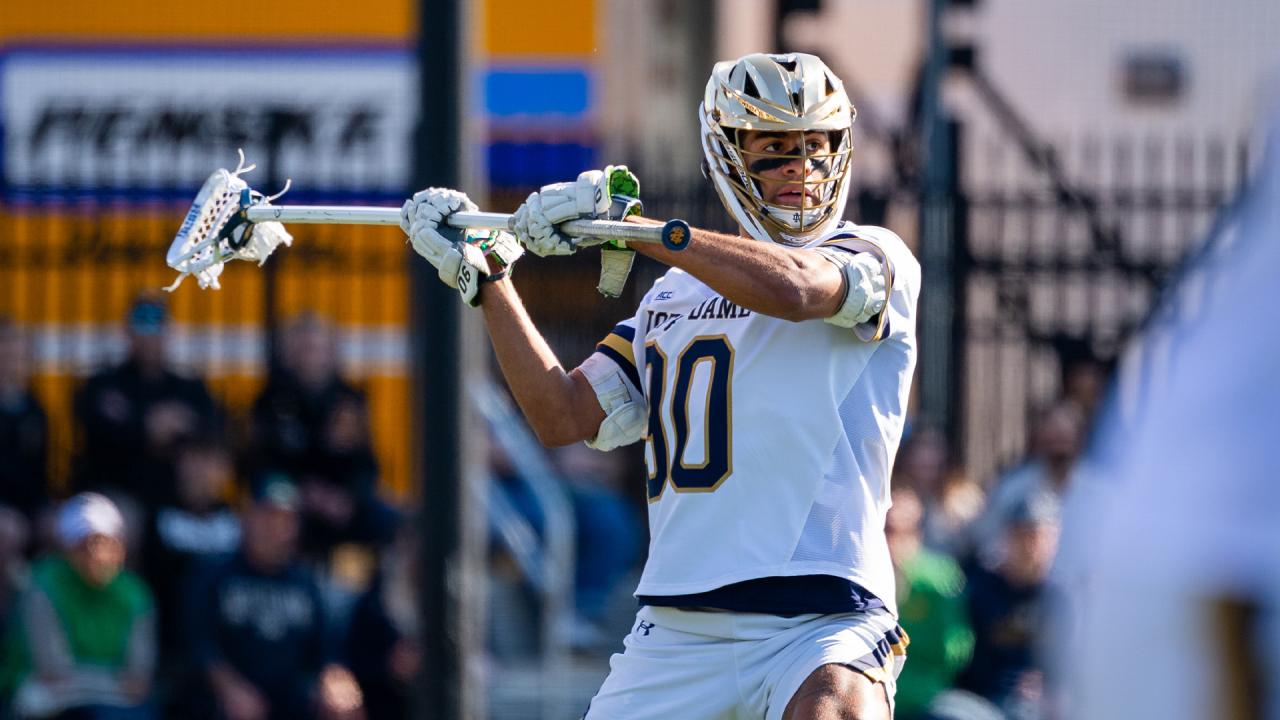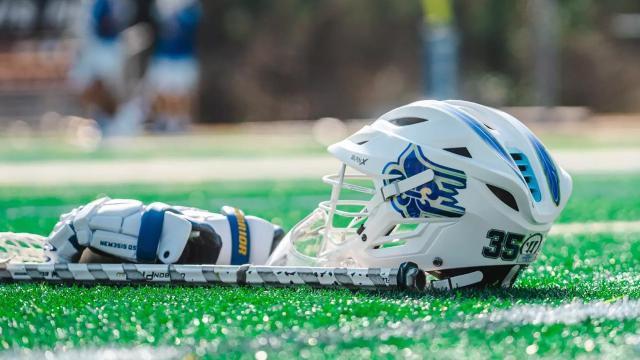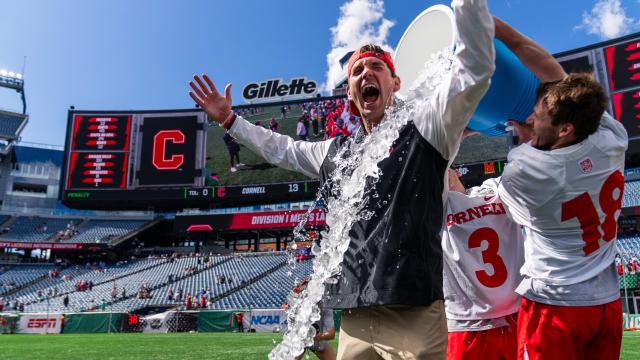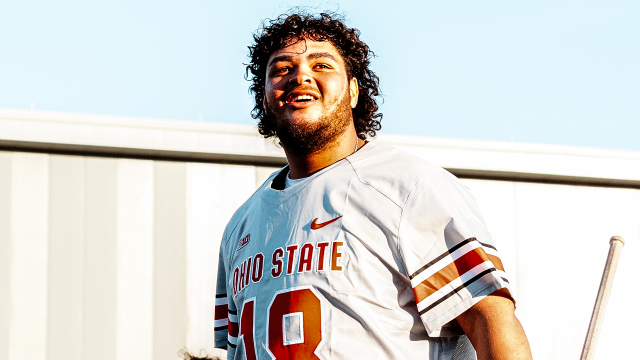
D-I Men's Bracket Analysis: Ohio State-Notre Dame All About Geography
This wasn’t the most complicated year to stitch together the Division I men’s lacrosse bracket.
It doesn’t mean the NCAA committee tasked with doing so took it easy over the weekend.
“We did have to watch those last few finals,” said Rutgers deputy AD Matthew Colagiovanni, the five-person committee’s chairman. “We were pretty locked in. We were waiting all the way to the end of the Ivies.”
In the end, it was not a night of many surprises. Arguably the biggest was the pairing of Ohio State and Notre Dame in the first round. The usual big questions of who was the No. 1 seed and who got the last spot in the field did not go in unexpected directions.
Which is not to say the latter didn’t occupy a lot of attention. It was clear by Friday night — after possible bid-snatching runs by Rutgers and Yale were halted in their conference semifinals, after Syracuse solidified its position with a victory over Notre Dame in the ACC semifinals, after both Army and Harvard lost league semifinals — which two teams’ resumes would get dissected.
Harvard or Army. Army or Harvard. Ultimately, it was the Crimson that earned a ticket to the Dome to play Syracuse.
“We spent the most time on those two teams,” Colagiovanni said. “We look a lot of matchups, but that was the one when we first arrived that we looked at. We looked at it all weekend, as people are winning their conferences, the RPI is going to be adjusted and go up and down. We looked at that and wanted to make sure we covered everything we could up until we handed the selections in.”
THE FAVORITE
Cornell
The top-seeded Big Red (14-1) are the only team to make it through the regular season with only one loss, and it just dropped a combined 41 goals on Yale and Princeton in the Ivy League tournament.
Cornell has the best player in the country in CJ Kirst, but the cast surrounding him — Michael Long, Ryan Goldstein, Willem Firth, Hugh Kelleher and more — are exceptional.
With Kirst entering his final postseason and a large senior class ready to head out the door in Ithaca after this postseason, the window for the program’s first national title since 1977 isn’t going to get bigger. Cornell averaged 16.2 goals, the most in the country and two more than anyone else in the field.
If someone is to beat the Big Red, it’s going to require an offense that can win a hectic, frenetic, high-scoring game.
LAST TEAM IN
Harvard
The Crimson squeak into the field, much like they did when they last appeared in the tournament in 2022. That was a team loaded with young talent, and even if its first-round trip to Rutgers didn’t go well, it seemed like that core group would have more opportunities down the road.
Now the likes of Sam King are seniors, and Harvard is getting its second shot. To move on in the tournament, it needs to beat Syracuse in the Dome twice in a season. The next team to do that will be the first. In fact, the last team to win at Syracuse twice in a season was the Onondaga Nation in 1918.
FIRST TEAM OUT
Army
The Black Knights’ 16-13 loss to Colgate in the Patriot League semifinals was enough to bump them from the field. Army (12-2) had lost only one other time — a 10-9 overtime setback against Boston U on March 22 — but its RPI and strength of schedule deficits relative to Harvard were too much to overcome.
It’s an excruciating end for a 22-man senior class that includes attackman Jackson Eicher, faceoff ace Will Coletti and defenseman AJ Pilate. After Army’s trip to the quarterfinals in 2023, it seemed like it could have a multi-year reign in the Patriot. Instead, consecutive semifinal losses have left the Black Knights numb the last two years.
TOUGHEST DRAW
Ohio State
The Buckeyes’ reward for winning 14 of their last 15 and claiming both the regular season and conference tournament titles is … a matchup with two-time defending national champion Notre Dame.
It’ll be a cranky bunch making its way to Columbus. The Fighting Irish (8-4) are unseeded, maybe the closest thing to even a mild surprise on a fairly sedate night. They’re coming off an ACC tournament loss to Syracuse. And they lost by a goal to Ohio State two months ago.
And if Ohio State navigates that game, conference rival Penn State — another team that fell to the Buckeyes earlier this season — could be waiting in the quarterfinals.
If Nick Myers’ bunch makes it to Foxborough, it will have earned it.
We spent the most time on those two teams.
Committee Chair Matthew Colagiovanni on Harvard vs. Army
UPSET ALERT
Richmond vs. North Carolina
The Spiders won’t be daunted by an ACC opponent; they beat Virginia and took Duke to overtime earlier this season. And they won’t be bothered by the stage; a good chunk of the roster was in the program when Richmond lost in the first round at Virginia in 2023, and some were around for the 2022 near-miss at Penn.
And then there’s the defense, which isn’t fun for anyone to contend with.
There’s also the North Carolina slice of the equation. Does the version of the Tar Heels that won at Syracuse to close the regular season show up? Or the one that faded against Notre Dame in the second half a week before that and got blitzed by Duke in the ACC semifinals?
The Tar Heels have some potent offensive options in Owen Duffy and Dominic Pietramala, but their offense has had its share of struggles over the last four games. Richmond is not a team that is forgiving to offenses trying to rediscover their edge.
THE BIG QUESTION
How did the Harvard-vs.-Army comparison get settled?
Carefully and thoroughly.
But it’s a numbers-driven process, and Harvard had the better RPI (11 vs. 12), the better strength of schedule (14 vs. 26), a slightly better top victory (Syracuse compared to North Carolina) and a slightly deeper collection of top-20 victories.
That left Army on the wrong side of things. One big unknown: What would that decision have looked like if Army had won Friday and then dropped a conference title game.
“I would say we watched the ESPN reveal, and they kind of hit all the points that we would have said, criteria-wise,” Colagiovanni said. “If they advance a little further in the conference tournament, we could have had a little different conversation on it. When you go through all the data for Harvard vs. [Army], our criteria just favored Harvard, and that’s how we went with that selection.”
OTHER QUESTIONS
What tipped the No. 8 seed to North Carolina?
From the outside, the North Carolina-vs.-Notre Dame comparison looked like it would generate some robust discussion. And it did, with the Tar Heels (10-4) getting the nod over the Fighting Irish (8-4) despite a 12-6 loss at home in a head-to-head matchup last month.
The Tar Heels finished ninth in the RPI, while Notre Dame was 10th. Richmond, at No. 8, was part of the number-crunching as well, and the Spiders will head to Chapel Hill for the tournament’s opening game.
“I think when you look at UNC, it was close,” Colagiovanni said. “They beat Syracuse; Notre Dame lost to Syracuse twice. They had more wins. Richmond was in the mix, too, when you look at their numbers, they were impressive, but they ended up with only two top-20 wins. When we looked at everything together, our decision was to go forward with UNC.”
How about the No. 5 seed to Penn State?
That one was all about the metrics and the biggest win on the board. The Nittany Lions finished fourth in the RPI, while Syracuse got up to No. 6 with its ACC tournament charge. Plus, Penn State had a victory no one else did: Its March 8 victory at Cornell. That was enough to offset Syracuse’s strength of schedule advantage (the Orange was No. 2, while Penn State was No. 7).
“The strength of schedule and the RPI for Penn State was really strong,” Colagiovanni said. “Penn State was the one team that was able to beat Cornell, which was a huge win, and they ended up winning their conference. Very close. Once Syracuse won the conference championship, it made it very tight for us. We ended up looking at the data, the top-20 wins and everything, and we felt like Penn State was one step above.”
Did Cornell need to win the Ivy League tournament to land the No. 1 seed?
That seems to be the case, particularly since the Big Red didn’t vault to No. 1 in the RPI until after beating Princeton 20-15.
“If it was a different outcome, it could have adjusted things,” Colagiovanni said. “But looking at Cornell with their seven top-20 wins, their RPI, their overall record. They had a loss to Penn State and their body of work [was good]. Maryland’s is very, very impressive, but that final decision was today and that made them the clear No. 1.”
And what were the bracket mechanics that landed Notre Dame in Columbus?
Geography, geography, geography.
With ACC teams seeded at Nos. 6, 7 and 8, whoever was shipped on the road was going to get a tough matchup, likely at a Big Ten school. For a good chunk of the last week, Syracuse going to Penn State seemed like a possibility, since the distance between the two schools was inside the NCAA’s 400-mile bus trip radius.
Instead, with Notre Dame the team shut out of the home game, the committee opted to pair the two schools that would have otherwise required an opponent to use a flight.
“I think when you look for our needs, we seed one through eight and then geography comes into position for that,” Colagiovanni said. “Then you also have to factor in the ACC teams. So we ended up having a bunch of them and several Big Tens. When you factor it all in, that’s what ended up making that matchup occur.”
When we looked at everything together, our decision was to go forward with UNC.
Committee Chair Matthew Colagiovanni on North Carolina earning the No. 8 seed
PAYBACK TIME
Syracuse vs. Harvard | Notre Dame at Ohio State | Colgate at Penn State
There will be at least three rematches from the regular season in the first round. Syracuse lost 15-14 to Harvard on Feb. 22, a result that went a long way toward getting the Crimson into the tournament.
Meanwhile, Notre Dame dropped a 10-9 decision to Ohio State on March 8 thanks to Shane O’Leary’s goal with seven seconds to play. Colgate opened its season Feb. 1 with a 14-9 loss at Penn State.
“There was only so much you can do, and obviously, teams play out of conference,” Colagiovanni said. “Our big objective is to not have the conference rematches in this. More than anything, that’s our big one. I think it’s just the way it laid out. Kudos to some of the teams that go out of conference to play some really good opponents.”
There could be a fourth rematch. UAlbany lost 18-11 at Cornell on April 1. If the Great Danes beat Siena on Wednesday, they would head back to Ithaca.
NAMES TO KNOW
A Aidan Carroll, Georgetown. The full list of Hoyas to ever produce multiple 60-point seasons: Jake Carraway, Greg McCavera and Carroll, who has 42 goals and 24 assists in 2025 after a 10-point outburst in the Big East final against Villanova.
FO Bo Columbus, Robert Morris. The Northeast Conference player of the year ranks third nationally (and first among those in the postseason) with a .648 faceoff percentage. He’ll be a key figure not only in the Colonials’ play-in game, but also in the first-round game against Maryland if his team advances.
M Liam Connor and A Rory Connor, Colgate. So many options with the Raiders, so here’s a nod to brothers who have combined for 164 points. Liam Connor (38 goals, 47 assists) had 19 points over three Patriot League tournament games, while Rory Connor has 47 goals and 32 assists entering the postseason.
M Sam English, Syracuse. The raw numbers (20 goals, 11 assists) don’t necessarily pop off the page, but English is an old-school, do-everything middie who is one of the Orange’s most valuable players.
G Caleb Fyock, Ohio State. With a nickname like “Big Tasty,” Fyock should already be a household name. He takes up a lot of space in the cage, but his agility and nimbleness are attention-grabbing traits. So is a .620 save percentage that should have him in line to be a first team All-America selection.
A Chris Kavanagh, Notre Dame. The senior has 33 goals and 23 assists on the season and now ranks second on the Irish’s career scoring list with 145 goals. He’s also third in school history with 232 points, putting three Kavanaghs — including Pat (301) and Matt (225) — in the top four.
A Sam King, Harvard. The senior attackman was held without a goal for the first time all season Friday against Princeton. He’s done plenty of damage all spring, collecting 35 goals and 29 assists in getting the Crimson back to the NCAA tournament.
A CJ Kirst, Cornell. The presumptive Tewaaraton favorite owns the Division I record for career goals and will look to bookend his career with a second trip to Memorial Day weekend. As a freshman in 2022, Kirst helped the Big Red reach the national title game before falling to undefeated Maryland.
A Coulter Mackesy, Princeton. The senior’s next goal will break a tie with late 1990s star Jesse Hubbard atop Princeton’s career goals list. Mackesy has 40 goals and 15 assists this season as part of a starting attack line that includes three 40-point scorers.
SSDM Aidan Maguire, Duke. It’s not every day a short stick shares the ACC’s defensive player of the year honors, a nod that does plenty to illustrate just how valuable the junior is. He ranks second on the Blue Devils in caused turnovers (26) and also has six goals and four assists as a threat in transition.
A Pratt Reynolds, Siena. Division I’s No. 2 goal scorer, Reynolds found the net 55 times while earning the Metro Atlantic’s player of the year award and leading the Saints to their first NCAA tournament since 2014.
A Silas Richmond, UAlbany. The junior from British Columbia had a good week. He picked up the America East’s offensive player of the year nod, then had back-to-back hat tricks as the Great Danes defeated UMBC and Bryant to earn a second NCAA bid in a row. Richmond has 39 goals and 43 assists on the season.
D Will Schaller, Maryland. The Terrapins were a relatively anonymous bunch on close defense entering the season after Ajax Zappitello’s graduation. That’s no longer the case thanks to the high-effort Schaller, who was one of one of the country’s most consistent defensemen and was the Big Ten’s defensive player of the year.
D Hunter Smith, Richmond. The Spiders’ defense isn’t lacking for standouts, whether it’s Mount St. Mary’s grad transfer Mitchell Dunham, high-impact long pole Tommy Stull or exceptional short stick Jack Pilling. Smith does a bit of everything for an ultra-cohesive unit, a group that will get tested by North Carolina’s star attackmen in the first round.
A Matt Traynor, Penn State. A deserving winner of the Big Ten’s offensive player of the year award, Traynor has 33 goals and 16 assists and is on the cusp of back-to-back 50-point seasons. He’s the centerpiece of an offense that features six other players with between 24 and 33 points.
FO Brady Wambach, North Carolina. The sophomore has won 64.3 percent of his draws and gives the Tar Heels a chance to dictate what sort of tempo they’d like to employ. He’s arguably Carolina’s most consistent player.
A Mikey Weisshaar, Towson. Moved from midfield to attack early in the season, the junior has 46 goals and 22 assists and collected the CAA’s offensive player of the year nod while helping the Tigers plow through the conference without a loss for the second consecutive season.
A Josh Yago, Air Force. Yet another conference’s offensive player of the year helped his team win a league tournament last weekend. Yago has 34 goals and 31 assists for the Atlantic Sun champions.
DON’T BE SURPRISED IF …
Maryland makes another national title game
The Terrapins have made it to Memorial Day in eight of the 13 tournaments since John Tillman took over the program. Maryland is 10-1 in quarterfinals in that span, and it defeated both of the seeded teams it might face in a semifinal (Princeton and Syracuse). The Terps’ run to the final a year ago was a surprise given how March and April went for them. They won’t be an unexpected title game participant if they make an encore trip.
YOU’LL HEAR A LOT ABOUT …
Syracuse’s semifinal drought
For a program whose fans once enjoyed 22 consecutive trips to the semifinals, the last dozen years haven’t been much fun. Syracuse hasn’t played on the season’s final weekend since 2013, and it hasn’t won a national title since Cody Jamieson’s overtime winner against Cornell on Memorial Day 2009.
The Orange missed the 2022 and 2023 tournaments, but made it back into the field last season before falling by a goal in the quarterfinals to Denver. Continuing an upward trajectory means going a weekend further, and the NCAA certainly wouldn’t mind seeing a large band of Syracuse fans buy tickets and make the trip across Interstate 90 to the Boston area in a few weekends.
COMPLETELY RANDOM STAT OF NOTE, PART I
Georgetown owns the second-longest active NCAA tournament streak
The Hoyas’ seven consecutive Big East titles means they have made the last seven NCAA tournaments. Only Maryland, which has made all 22 postseasons since the field expanded to 16 in 2003, owns a longer streak.
It’s not as if anyone else is particularly close to Kevin Warne’s program. The third-longest active streak belongs to Princeton, which has made the last four tournaments since the program resumed play in 2022 after the Covid-19 pandemic effectively shut down the Ivy League for most of 2020 and all of 2021.
COMPLETELY RANDOM STAT OF NOTE, PART II
The Empire State has five teams in the NCAA tournament for the first time in a decade
The New York quintet of UAlbany, Colgate, Cornell, Siena and Syracuse matches the largest contingent from the state since 2015, when Marist won the Metro Atlantic rather than Siena and the other four teams in this year’s field also advanced to the postseason.
The record for any state remains the six teams Maryland sent to the tournament in 2007 (Johns Hopkins, Loyola, Navy, Maryland, Towson and UMBC).
COMPLETELY RANDOM STAT OF NOTE, PART III
Syracuse isn’t playing its traditional 7:30 p.m. game on Sunday
Ever since ESPN began televising every first round game in 2007, there was one certainty: If Syracuse was hosting, it was going to have the late game on Sunday. The reason: It’s graduation weekend at the Dome.
The Orange played 11 first-round home games in that span, all drawing the 7:30 p.m. start. That streak barely ended this year, as Harvard makes its way to Syracuse for a 5 p.m. game on Sunday. Cornell’s date with either Albany or Siena will instead be the anchor game for the first round.
GRADING THE COMMITTEE
A-
There were relatively few teams to delve into this season, and the process appeared fairly straight forward.
Given how numbers driven it is, Cornell at No. 1 is not a shock. The last time a team ranked first in the RPI wasn’t the No. 1 seed was 2015.
Maryland, with its seven top-10 victories, was an easy choice for the No. 2 seed. Princeton’s metrics made it a clear No. 3.
Penn State vs. Syracuse looked like a tossup. Giving the advantage to Penn State in part because it beat Cornell makes sense.
North Carolina vs. Notre Dame for the No. 8 seed could have gone the other way, in no small part due to the Irish’s head-to-head win. And it’s debatable how good of an argument it is that the Tar Heels had more wins than Notre Dame when it’s at least partially a function of scheduling two more regular season games.
Remarkably, the committee stitched together a bracket that might require no first-round flights. Play-in participant Air Force goes to Robert Morris on Wednesday, but no one else has to get on a plane in the first weekend.
That compact geography might have made it possible to flip the opponents for Ohio State and Penn State, sending Notre Dame to Happy Valley and Colgate to Columbus. Both would have required flights, but it would have been a boost for bracket integrity.
But outside of Notre Dame (which was going to get a tough matchup against one of those Big Ten teams if it was sent on the road) and Ohio State, there shouldn’t be too much grumbling anywhere. For the most part, Sunday was not a night for the unexpected.
Patrick Stevens
Patrick Stevens has covered college sports for 25 years. His work also appears in The Washington Post, Blue Ribbon College Basketball Yearbook and other outlets. He's provided coverage of Division I men's lacrosse to USA Lacrosse Magazine since 2010.

Categories
Tags
Related Articles




